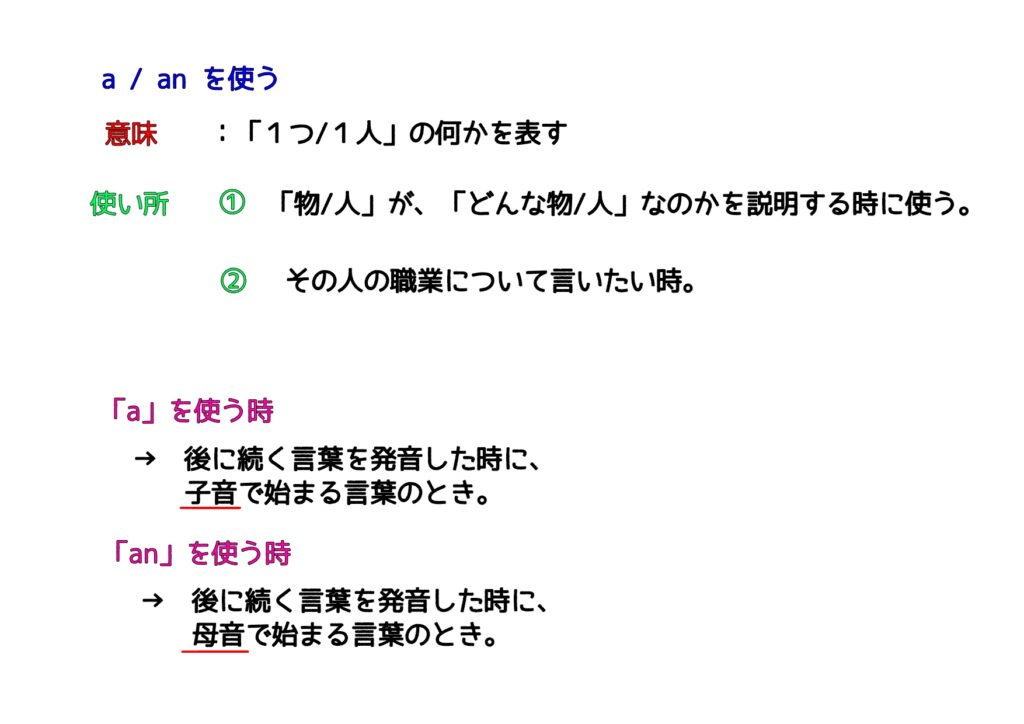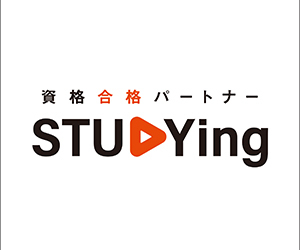第44回:a / an, oneを名詞の前で使い分ける

どれも、「一つの」を表しますが、どのように使い分けるのでしょうか?
Q. この記事で、一番大事なことって何?
A. 大事なことを、1枚の画像にまとめました。

いちいちノートにまとめるのが面倒だという方、また、
ノートにまとめることが苦手だという方は、ご活用ください。

[広告]
確かな英語力は、日々の継続から。
その継続を後押しする、第二言語習得理論に基づいた
オンライン英語学習プログラムがあります。
英語を使う人のための、確実なスキルアップが望める
7日間の無料体験はこちらから!

不定冠詞「a/an」と「one」の使い方
- a/anの使い方:
・子音で始まる単語や子音の発音がする単語には”a”を使います。
例)a university, a European, a one-parent family
・母音で始まる単語や発音が母音で始まる単語には”an”を使います。
例)an Italian, an umbrella, an hour, an honour, an orange
・A, E, F, H, I, L, M, N, O, R, S, Xから始まる略語には”an”を使います。
例)an MP, an FBI agent, an IOU
・略語が単語として発音される場合は”a”を使います。
例)a NATO general, a FIFA official
・ただし、略語が単語として発音されない場合は”an”を使います。
例)an OPEC meeting - a/anとoneの使い分け:
・a/anは、ある特定のものや事柄を指す場合に使います。
例)I really need a cup of coffee.
・数や量を表す表現にも”a/an”を使います。
例)three times a year, half an hour, a quarter of an hour, a day or so, 50 cents a litre
・”a/an”と”one”は、単数可算名詞については同じように使えます。
例)We’ll be in Australia for one year. → We’ll be in Australia for a year.
・”one”を使うと、時間や量などが強調されます。
例)He weighs one hundred and twenty kilos!
・ただし、1つだけを指す場合は”one”を使います。
例)Do you want one sandwich or two? - oneの使い方:
・”one”は、1つのものを強調する場合に使います。
例)I just took one look at her and she started crying.
・”one”を使うことで、1つのものが明確になります。
例)Are you staying only one night?
・”one”を使った表現として、”one…other/another”があります。
例)Close one eye, and then the other.
・また、”one day”、”one evening”、”one spring”などのように、特定の日や季節を表す場合にも使います。
例)Hope to see you again one day.
具体例
- Examples of using “a/an”:
- I saw a black cat on my way home. (the noun “cat” starts with a consonant sound)
- An hour ago, I finished my work. (the noun “hour” starts with a vowel sound)
- She is a one-parent family. (the phrase “one-parent family” starts with a consonant sound)
- An FBI agent visited our office yesterday. (the abbreviation “FBI” is pronounced as “ef bi ai” which starts with a vowel sound)
- Examples of using “a/an” to talk about a particular but unspecified person, thing, or event:
- I need a new phone. (referring to a particular but unspecified phone)
- Can you lend me a pen? (referring to a particular but unspecified pen)
- I have a meeting tomorrow. (referring to a particular but unspecified meeting)
- She is looking for a job. (referring to a particular but unspecified job)
- Examples of using “one” to emphasize the length of time, quantity, amount, etc.:
- He ran for one hour without stopping. (emphasizing the length of time he ran)
- I only have one dollar in my wallet. (emphasizing the small quantity of money)
- She has only been to one country in her life. (emphasizing the small amount of travel experience)
- I can eat only one piece of cake. (emphasizing the small quantity of food)
- Examples of using “one” to talk about only one thing or person rather than two or more:
- Can I have one hamburger, please? (referring to only one hamburger)
- I’m staying for one night only. (referring to only one night)
- I bought one book and one pen. (emphasizing the specific number of items)
- He has only one sister. (emphasizing the specific number of siblings)
- Examples of using “one” in phrases such as one day, one evening, one spring, etc.:
- One day, I hope to travel to Japan. (referring to a particular but unspecified day in the future)
- I remember one evening when we had a great time together. (referring to a particular but unspecified evening in the past)
- One spring, I planted a beautiful garden in my backyard. (referring to a particular but unspecified spring in the past)
[広告]
TOEICのスコアを上げたいけれど、
まとまった勉強時間が取れなくて困っている…
なら、細かいスキマの時間を使いながら、
少しずつスキルを積み重ねてみてはどうでしょう。
スマホ1つでスコアアップが出来る、
オンライン講座のリンクはこちらから。

Q. この文法はどうやって使うのでしょうか?
A. 今回の文法を活用した会話文を見てみましょう。

Hey, do you want to come with me to the mall?
(一緒にショッピングモールに行かない?)

Sure, I want a new shirt.
(いいよ、新しいシャツが欲しいんだ。)

Great! How about we meet there in half an hour?
(いいね! 30分後にそこで会おうか?)

Sounds good, I’ll see you in a bit.
(いいよ。また後でだね。)

Perfect, I’ll grab a coffee while I wait.
(待ってる間にコーヒーでも買ってるよ。)

I might do the same. Can I get you one too?
(私もそうしようかな。自分が買っておこうか?)
[広告]
ロゼッタストーン・ラーニングセンターで、最先端の教育制度を活用して英語を学びませんか?私たちは個々の学習ペースに合わせてeラーニングと対面教育を組み合わせ、柔軟な学習環境を提供しています。自宅でのeラーニングと対面教育のメリットを最大限に活かし、あなたの英語学習をサポートします。最新のテクノロジーと個別の指導が組み合わさった当センターで、自由な学習スタイルを体験してみませんか?英語学習を楽しく効果的に進めるための環境がここにあります。新たな一歩を踏み出して、新しい英語学習の旅に参加しましょう!

Q. この記事の要点は?
A. a/an, one の使い分けを確認しました。
- 「A」は、子音音で始まる名詞や名詞句の前に使われます。母音の文字で始まるが、子音音で始まるものも含まれます。
- 「An」は、母音音で始まる単語の前に使われます。無音の「h」を含む単語や、一部の略語も含まれます。
- 「A/An」は、特定されていない人、物、またはイベントについて話す場合、数量や数式の表現、所有格の「a…of…」の形式にも使用されます。
- 「One」は、1つのものや人物に言及することを強調する場合に「a/an」の代わりに使用することができます。
- 「One」は、「one day」などのフレーズで特定されているが未指定の日などを意味するためにも使用されます。
英会話を始めてみたいけれど、どのサービスが良いか分からない…
そんな方は、まず、この記事で3つのサービスを比べてみてはいかがでしょうか?
英語力を効率良く伸ばすことができるサービス3選です。

次回の文法解説は?
A / an, the そして、冠詞を使わない時
この記事を作る際に参考にした文法の解説書になります。
すべて英語で書かれていますが、練習問題が付いてます。
イギリス英語なので、スペル等の表記が異なる部分もありますが、
「使い方を練習したい」「繰り返し問題を解きたい」
という方は、使ってみても良いかもしれません。

関連記事一覧
他の文法解説記事を検索できます。





-320x180.jpg)







コメント